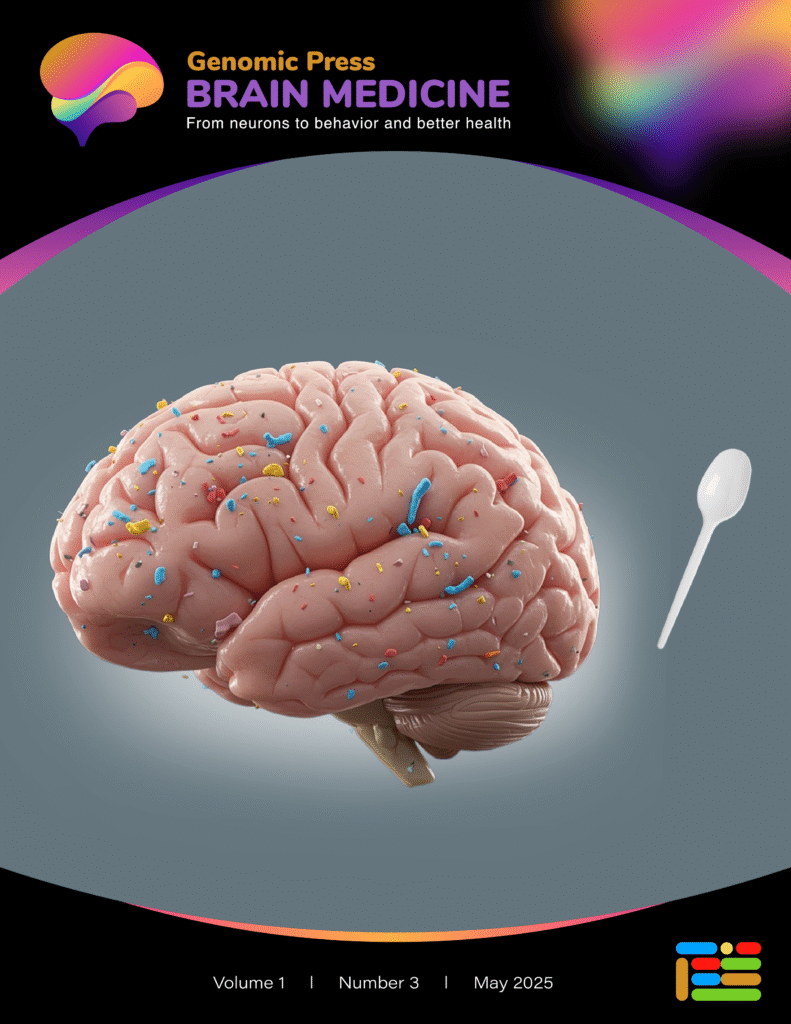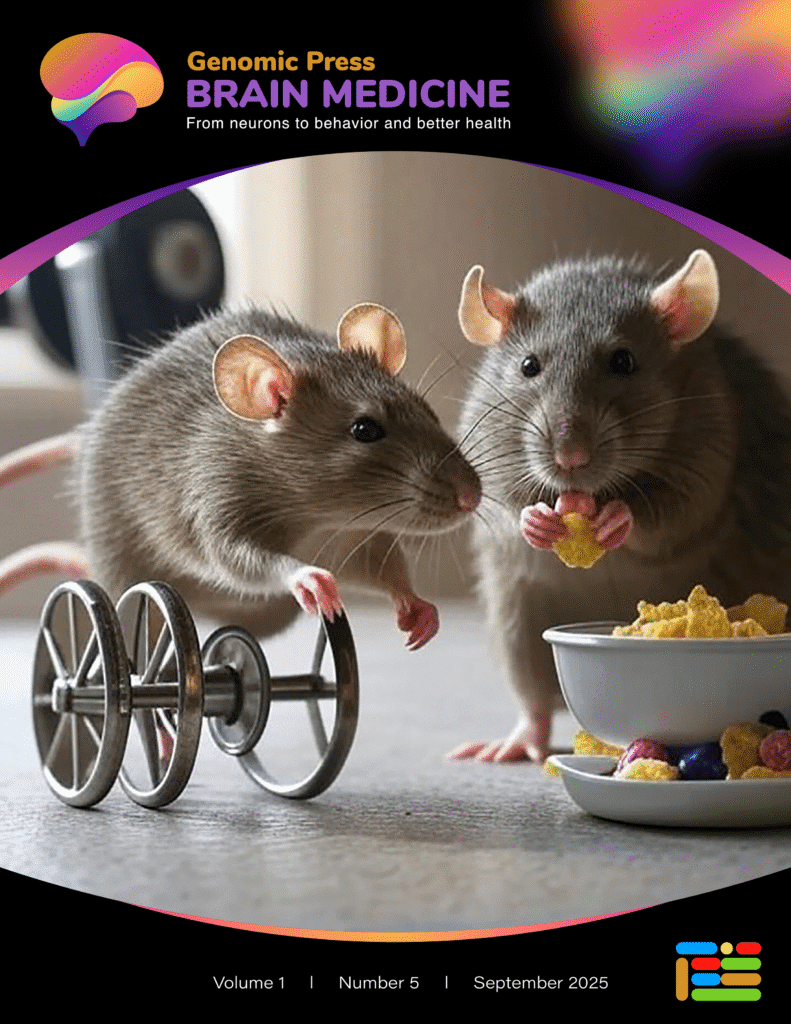Genomic Press: Global Research Impact
Transforming Scientific Publishing Worldwide
Your Research, Everywhere

BRAIN MEDICINE
A New Field Emerges
The First Publication to Launch a Field, Not Follow One
Medical journals emerge after fields are established. Brain Medicine reverses this: we are the publication establishing a new medical discipline. While pioneers envisioned this integration, we provide the platform where it is now a reality. We unite every specialty where brain function determines health. From molecules to populations, we catalyze how medicine understands and heals the brain.
Uniting All Brain Disciplines
One platform where every specialty converges
Neurology
Psychiatry
Neurosurgery
Radiology
Ophthalmology
Otology
Explore Our Published Research →
Transforming Brain Health at Every Level
Molecular to Clinical
Bench discoveries to bedside breakthroughs
Individual to Population
Precision medicine meets public health
Today to Tomorrow
Shaping the future of brain medicine
Be part of the publication establishing a new medical discipline
Start Your Publishing Journey →The breakthrough. Your research.
Our reach.
The breakthrough.
In the Spotlight
Exercise vs. Junk Food:
Can Movement Rescue Your Brain?
Nolan and colleagues at University College Cork, Ireland, found that voluntary exercise mitigated cafeteria diet-induced depression-like behavior in adult male rats, reducing immobility in forced swim tests. Exercise attenuated diet-induced increases in plasma insulin and leptin, and changes in caecal metabolites including anserine, indole-3-carboxylate, and deoxyinosine. While exercise promoted hippocampal neurogenesis and increased GLP-1 levels, cafeteria diet blunted these beneficial effects. Specific caecal metabolites correlated with depression and cognition behaviors. The key message: exercise can counteract some mental health consequences of unhealthy diet, but dietary quality remains essential for maximizing exercise benefits on brain health.
Source article:
Nota MHC et al. Exercise mitigates the effects of a cafeteria diet on antidepressant-like behavior associated with plasma and microbial metabolites in adult male rats. Brain Medicine 2025
Accompanying editorial:
Licinio J et al. Exercise as metabolic medicine: Movement counters diet-induced behavioral despair via gut-brain signaling. Brain Medicine 2025.
Featured in
200+ news stories in
10+ languages worldwide
Human microplastic removal: what does the evidence tell us?
Open Access paper by N Fabiano et al.
Therapeutic apheresis: A promising method to remove microplastics?
Open Access paper by SR Bornstein et al.
NK3R antagonism reduces fear expression in a PTSD-like model.
Open Access paper by N Acharya et al.
Manic symptoms in schizophrenia spectrum disorders.
Open Access paper by EM Tsapakis et al.
Maternal immune activation reduces hippocampal neuron excitability in newborn rats: developmental implications.
Open Access paper by L Moravcikova et al.
Air pollution: an emerging risk factor for autism spectrum disorder.
Open Access paper by SK Ojha & H Amal
An overview of the life and career of Seymour Reichlin, MD, PhD.
Open access paper by R Lechan & R Toni
A debt owed to a wonderful mentor, Seymour Reichlin.
Open Access paper by Joseph B. Martin
Acute MS manifestations predict functional outcomes.
Open Access paper by JPF Gonçalves et al.
Prescription drug disruption of sterol biosynthesis: implications for brain development.
Open Access paper by Ž Korade & K Mirnics
Alpha-particle therapy for neuroendocrine tumors: A focused review.
Open Access paper by KM Shekhda et al.
Neural basis of cognitive generalization across species: hippocampus and cortex.
Open Access paper by Z Quan et al.

100+ Published Articles
Across All Brain Disciplines
Here you will find our entire issues. Click on the cover and you will go to the full Open Access digital issue.
If
your work
is not aligned
with existing

Brain Medicine has gone viral
Rachel E. Gross’s New York Times feature, referencing work published in Brain Medicine by Dr. Hyman Schipper, explores how estrogen and other sex hormones profoundly affect brain health and neurological disease in both men and women. The article explains that estrogen, once viewed mostly as the “female sex hormone,” is now recognized for its essential functions throughout the body—including strengthening bones, regulating metabolism, and supporting the central nervous system.
Gross discusses how recent advances show brain tissues are filled with estrogen receptors, and both sexes actually produce estrogen in the brain.
These receptors help estrogen modulate neuron firing, metabolism, inflammation, and neuroplasticity across the lifespan—from embryonic development to menopause. The piece details how research (often in Brain Medicine) links sex hormone fluctuations to MS, Alzheimer’s, epilepsy, and migraine. Dr. Hyman Schipper emphasizes that many neurological diseases are impacted by these hormonal changes, and therapies from reproductive medicine could potentially be repurposed for brain disorders.
The article highlights missed connections between neurology and gynecology, advocating for neurologists to directly consider hormonal cycles in managing epilepsy, migraines, and medication interactions. As science advances, hormone-based therapies are being explored for conditions like Alzheimer’s, though care must be taken in understanding the complex hormone system.
About The New York Times
Founded in 1851, The New York Times is one of the world’s most prestigious newspapers, with unmatched authority in global science and health reporting. Its coverage reaches over 10 million subscribers worldwide and continues to set international standards for investigative and medical journalism.
SOURCES
For more, read the original work by Rachel E. Gross, with insights from Dr. Hyman Schipper, in The New York Times (archived HERE).
Also see the referenced research in Brain Medicine. 
The Washington Post covered the Brain Medicine study confirming that microplastics are present not only in human organs but also in the brain at concentrations far higher than expected. Their article framed the research as a public health crisis, pointing out that microplastics are in our blood, liver, and brains — and almost impossible to avoid. The Post highlighted five science-based strategies: drink filtered tap water instead of bottled, replace plastic food containers with glass or stainless steel, avoid microwaving food in plastic, reduce consumption of highly processed foods, and ditch plastic tea bags.
About The Washington Post
Founded in 1877, The Washington Post is one of the most influential newspapers in the United States and globally. Known for its Pulitzer Prize–winning journalism, it has a strong record of health and science reporting that shapes both public understanding and policy.
SOURCES
Click HERE to explore the Brain Medicine article by N. Fabiano et al.
Click HERE to go to the news article in The Washington Post, which is also archived HERE.
The Associated Press distributed the Brain Medicine microplastics review through its global news wire, emphasizing the stark finding that human brains contain approximately “a plastic spoon’s worth” of microplastics.
The AP coverage highlighted the 3-5 fold increase in microplastic concentrations found in dementia patients and featured practical recommendations for reducing exposure. Their report emphasized the dramatic rise in brain microplastic levels between 2016 and 2024, describing it as an “alarming” environmental health crisis.
The AP article specifically quoted the researchers’ proposed lifestyle changes, including switching to HEPA filters, using recirculated air while driving, and avoiding plastic food containers.
About the Associated Press
Founded in 1846, the Associated Press is the world’s largest and most trusted news organization. As a not-for-profit news cooperative, AP’s content reaches more than half the world’s population every day through its 1,300 member newspapers and broadcasters. The organization has won 59 Pulitzer Prizes and maintains bureaus in 100 countries, making it the definitive source for breaking news globally.
SOURCES
Click HERE to explore the Brain Medicine article by N. Fabiano et al.
Click HERE to go to the news article distributed by the Associated Press.
Germany’s Süddeutsche Zeitung reported on the Brain Medicine study showing that microplastics are not only widespread in the environment but are now confirmed in human brain tissue. The article emphasized the discovery of particularly tiny particles (under 0.2 micrometers) that can cross the blood–brain barrier, with especially high loads found in dementia patients. SZ translated the science into consumer guidance, recommending readers cut back on bottled water, avoid heating food in plastic, and steer clear of plastic tea bags.
About Süddeutsche Zeitung
Founded in 1945 and based in Munich, Süddeutsche Zeitung is one of Germany’s most influential national newspapers. Known for deep investigative reporting and a strong science desk, SZ shapes European debates and is trusted worldwide.
SOURCES
Click HERE to explore the Brain Medicine article by N. Fabiano et al.
Click HERE to go to the news article in Süddeutsche Zeitung. Use your browser’s translate function if needed for other languages.
La Repubblica covered the Brain Medicine special issue with the headline: “Un cucchiaino di microplastiche nel nostro cervello. I ricercatori: possibile causa di demenza.” The article explains that researchers found enough microplastics in the human brain to fill a teaspoon, referencing a University of New Mexico study published in Nature Medicine. This prompted further investigation into how these fragments penetrate such a protected organ and what effects they have.
The Brain Medicine issue presents four studies suggesting that industrially processed foods are a major source of microplastics; ultra-processed foods, like chicken nuggets, contain microplastic concentrations 30 times higher than unprocessed chicken breast. The industrial processing and packaging are believed to leave plastic particles on foods. The mental health effects are described as “speculative,” but two observations are cited: a 2024 British Medical Journal study associating high consumption of ultra-processed foods with a 22% increase in depression risk and a 48% increase in anxiety, and the University of New Mexico autopsy study that found individuals with higher brain microplastics showed dementia about four times more often. The article emphasizes that these results demonstrate correlation, not direct causality, between consumption of ultra-processed foods, microplastics, and mental health issues.
On the environmental front, a Murdoch University study from Australia is mentioned showing that agricultural soils have microplastic concentrations 23 times higher than oceans, and that particles were found in vegetables like lettuce, carrots, and wheat destined for human consumption. The article also describes research into the presence of microplastics in other organs—placenta, atherosclerotic plaques—and notes the open scientific question regarding health effects from the thousands of chemical additives present in plastic materials.
Professor Ma-Li Wong is quoted: “If microplastics manage to breach even the barrier that protects the brain, what sacred boundary do we have left?” The editorial concludes that both processed and unprocessed foods can carry microplastics, highlighting the pervasive risk and the urgency for wider awareness.
About La Repubblica
Founded in Rome in 1976 by visionary journalists Eugenio Scalfari and Carlo Caracciolo, La Repubblica swiftly became Italy’s leading centre-left newspaper, celebrated for its independent spirit and incisive reporting. The paper’s stature has been enhanced by legendary contributors such as Enzo Biagi, Alberto Ronchey, and Bernardo Valli, who brought authoritative commentary and investigative journalism to its pages. Today, La Repubblica remains one of the country’s most-read dailies, shaping debate on Italian and European affairs and serving as essential reading for an engaged public.
SOURCES
Click HERE to explore the Brain Medicine article by N. Fabiano et al.
Click HERE to go to the Brain Medicine special microplastics issue.
Click HERE to go to the news article in La Repubblica – use your browser’s translate feature (if needed) for your preferred language.
This El País story, drawn from a Genomic Press Interview published in Brain Medicine, profiles Dr. Camilo de la Fuente-Sandoval—a research leader whose pioneering work has transformed the understanding and care of early-stage psychosis and schizophrenia, especially in Latin America.
The feature traces Dr. de la Fuente-Sandoval’s personal journey, beginning with his family’s move from Chile to Mexico and his early fascination with the neurobiology of psychosis during psychiatry training. At Mexico’s Instituto Nacional de Neurología y Neurocirugía, he founded the Laboratory of Experimental Psychiatry, which became distinguished for groundbreaking MRI spectroscopy studies on patients experiencing their first psychotic episode. His research revealed elevated glutamate levels in the associative striatum—a biomarker that normalizes with effective antipsychotic treatment. This discovery has led to more personalized medicine approaches and inspired the creation of an outpatient clinic that provides rapid, comprehensive, and free diagnosis for young people in Mexico City.
The Genomic Press Interview explores Dr. de la Fuente-Sandoval’s philosophy: the importance of scientific rigor, empathy, persistence, and focusing research directly on patient needs. He shares insights about building research infrastructure, the value of community, and his hopes for more widespread personalized care for psychiatric disorders. His achievements include winning the Schizophrenia International Research Society’s Global Award, leading international collaborations, and mentoring young scientists worldwide.
El País is Spain’s most widely read and internationally recognized daily newspaper, headquartered in Madrid. Founded in 1976 during Spain’s transition to democracy, El País quickly became an authoritative voice for progressive and centrist perspectives and rigorous journalism. It is respected for high editorial standards, comprehensive coverage of national and global news, and international influence across the Spanish-speaking world. Its website is the most accessed source of news in Spanish worldwide.
SOURCES:
Click HERE to explore the full Genomic Press Interview in Brain Medicine (Genomic Press, New York).
Click HERE to go to the news article in El País – use your browser’s translate feature (if needed) for your preferred language.
An article in El Español honors Dr. Seymour Reichlin, known as the “father of neuroendocrinology,” whose life and career continue to inspire the medical and scientific community at 101 years old. As featured in Brain Medicine and cited by colleagues such as Dr. Esther Sternberg and Dr. Joseph B. Martin, Reichlin’s work has defined how scientists understand the interaction between brain function, hormones, and stress.
Born in 1924 in New York to Russian-Jewish immigrants, Reichlin’s early experiences—ranging from medical service in WWII to excelling academically—shaped his curiosity about the links between emotional states and physical health. His clinical observations and pioneering experiments led to foundational concepts about the hormonal mechanisms behind stress and disease, specifically through cortisol research.
Despite his age, Reichlin remains intellectually and socially active, publishing articles and mentoring a wide network of researchers. As noted by Dr. Sternberg in Brain Medicine, Reichlin exemplifies patterns of “longevity exceptionalism,” including strong social bonds, lifelong curiosity, humor, spiritual exploration, and adaptability—qualities that modern research connects to healthier aging and preserved cognition. Notably, his creative pursuits include wood sculpture and harmonica playing, while his activism has supported both disadvantaged communities and historical recovery projects.
Reichlin’s key scientific milestones include mapping hormone pathways in the brain, developing assays for crucial neuroendocrine hormones, and establishing leading clinical centers. He continues to investigate the neurobiology of aging, emotion, and mysticism, challenging conventions about productivity and intellectual vitality in later life.
The article emphasizes that personal relationships—such as his decades-long mentorship of Dr. Joseph B. Martin—are integral to Reichlin’s resilience and ongoing impact. Colleagues praise his sense of humor, energy, and commitment to sharing knowledge across generations.
To explore this story in Spanish or another language:
Visit El Español at THIS LINK and use your browser’s translate function to access the full article and insights about Dr. Seymour Reichlin.
Sources:
Brain Medicine article by Dr. Joseph Martin.
Brain Medicine article by Dr. Esther Sternberg.
The South China Morning Post covered the Brain Medicine findings that microplastics are building up in the human brain, a place where they pose particular concern. The article emphasized not only the science — including evidence that levels are rising — but also practical advice for readers: avoid bottled water, choose ceramic or glass containers, and switch to plastic-free tea bags. SCMP framed the story as a public health wake-up call, urging individuals to take steps to limit exposure even as scientists continue to study long-term risks.
About SCMP:
Founded in 1903, the South China Morning Post is Hong Kong’s newspaper of record and a globally respected outlet for coverage of China, Asia, and international affairs. Its science and health reporting regularly informs both policymakers and the general public across continents.
SOURCES
Click HERE to explore the Brain Medicine article by N. Fabiano et al.
Click HERE to go to the news article in SCMP.
Why Brain Medicine Stands Apart
Your research deserves worldwide attention. Brain Medicine articles have been featured in The New York Times, The Washington Post, Nature Medicine, and over 4,000+ international news outlets, in 35+ languages, with 2M+ social media views.
Our recent microplastics study generated headlines across continents, reaching millions of readers beyond academia. We maintain active relationships with science journalists and issue professional press releases for high-impact papers. Your groundbreaking work won’t just sit in a database, it will spark conversations in newsrooms, policy meetings, and public forums.
The media exposure shown in the adjacent column—being featured in globally respected outlets such as The New York Times, The Washington Post, Associated Press, Süddeutsche Zeitung, La Repubblica, El País, El Español, and South China Morning Post—is a major achievement for any journal. Such diverse, high-profile international coverage signals strong editorial impact and makes Brain Medicine exceptionally credible worldwide.
This breadth of media recognition demonstrates that Brain Medicine is not only reaching experts but is also influencing public discourse internationally. For researchers, this type of exposure means their work can rapidly achieve visibility and recognition across continents.
Join authors whose research shapes both scientific discourse and public understanding of brain health.
Align your research with titans of neuroscience. Brain Medicine features contributions from former deans of top medical schools, chancellors of leading universities, and pioneers who have shaped modern neuroscience for over 50 years. Our editorial board includes award-winning scientists still making extraordinary discoveries and rising stars redefining the field. Guest editorials from legendary figures in brain research validate our authors’ work as “paradigm-shifting.” This is not just another journal: it is where tomorrow’s Nobel laureates publish today’s breakthroughs.
Time is brain cells and career momentum. While traditional journals leave your manuscript in limbo for months, Brain Medicine delivers rapid, fair peer review with swift editorial decisions. Our streamlined process means your accepted articles appear online within weeks, not seasons. Early Online Release ensures your findings reach the scientific community immediately upon acceptance, securing your priority and accelerating citations. Perfect for early-career researchers racing toward tenure or established scientists with time-sensitive discoveries. Do not let bureaucracy delay your impact.
Break down paywalls to multiply your influence. Every Brain Medicine article is immediately and permanently free to readers worldwide: no embargoes, no restrictions. Studies show open access articles receive 50% more citations and reach researchers in developing nations who drive innovation. Our Creative Commons licensing lets others build on your work while ensuring proper attribution. Your research becomes a public good, accessible to clinicians treating patients, policymakers drafting legislation, and students discovering their passion. Maximum visibility, maximum impact, zero barriers.
Brain Medicine is the pioneering journal for an entirely new discipline, Brain Medicine itself, which unites all of neuroscience with previously isolated specialties to revolutionize how we understand and treat brain disorders. We are the first to integrate neurology, psychiatry, psychology, ophthalmology, audiology, and mental health into one comprehensive platform. Traditional journals compartmentalize; we connect. Your manuscript linking retinal changes to dementia, hearing loss to cognitive decline, or immunology to depression finds its natural home here. Our readers span every brain-related field, from molecular neuroscientists to clinical psychologists, from vision researchers to psychiatric geneticists. This unprecedented scope means your work reaches audiences you never imagined, sparking collaborations across boundaries that no longer exist. Position yourself at the forefront of this new discipline where convergent thinking yields transformative discoveries.
Brain Medicine represents a rare alternative in scientific publishing: genuinely academic-driven rather than profit-maximized. Unlike major corporate publishers charging thousands in fees and predatory journals exploiting researchers, we operate just above cost to maximize author access.
Our APCs remain intentionally low because we prioritize scientific advancement over shareholder returns. Genomic Press is owned and operated by academics for academics, with surplus revenues reinvested in journal development, not extracted as profits. This sustainable model ensures editorial independence, maintains rigorous standards, and keeps publication accessible to researchers regardless of funding levels.
Your fees support actual publishing costs and scientific infrastructure, not corporate dividends. Choose a journal where your publication charges advance science, not stock prices.
Elevate your scientific profile through our prestigious “Innovators & Ideas” section featuring the exclusive Genomic Press Interview, where readers discover the brilliant minds behind today’s and tomorrow’s science. Join distinguished scientists across three categories: Rising Stars, Research Leaders, and Academic Leaders, whose in-depth profiles blend groundbreaking research with personal narratives.
These interviews have proven career-transformative, with featured scientists receiving prestigious international awards, including ECNP and WFSBP Lifetime Achievement Awards.
Our interviews amplify your research impact beyond traditional citations, creating lasting digital legacies that selection committees, grant reviewers, and institutional leaders reference. Multiple featured researchers credit their Genomic Press Interview as instrumental in award nominations, tenure decisions, and leadership appointments.
For readers, this is where cutting-edge science becomes personal, revealing the human stories driving revolutionary discoveries. This is not merely publication, it is career acceleration through strategic visibility that positions you among the most innovative minds shaping brain science today.
Yes, submitting to a newer journal involves calculated risk: that is precisely the opportunity. While Cell, Nature and Science accept less than 5% of submissions, Brain Medicine offers talented researchers a fighting chance at high-impact publication. Our selective 25-35% acceptance rate maintains quality while recognizing true excellence. Early contributors shape editorial direction, establish research niches, and build relationships with editors invested in their success. History shows that backing emerging journals with strong leadership and vision pays exponential dividends. Fortune favors the scientifically bold.

Courtesy of the Athinoula A. Martinos Center for Biomedical Imaging at Massachusetts General Hospital, affiliated with Harvard Medical School and MIT.
Released under the CC0 Public Domain Dedication.
This landmark imaging work embodies the mission of Brain Medicine ➔ Advancing understanding of the brain across every discipline.





 Ma Clinique
Ma Clinique

















